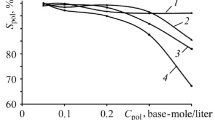Abstract
To improve the performances of a composite based on silica and unsaturated polyester resin, modification of silica surface and addition of a dispersing agent are required. The surface of raw silica was modified with vinyltrimethoxysilane in acidic conditions, adding methacrylic acid. Moreover, to enhance the compatibility between silica and polyester resin, a block copolymer which reacts as a dispersing agent was added. The mixture of these components is named “Giral.” The mechanism of interaction of the different components of the “Giral” with the raw silica is described. Adding this formulation to a mixture of polyester resin and silica leads to a decrease of the viscosity of the polyester resin/silica system and the mechanical properties of the composite thus formed are improved.











Similar content being viewed by others
References
Gay D, Suong VH, Stephen WT (2003) Composite materials: design and applications. CRC Press, Boca Rotan
Chawla KK (1998) Composite materials: science and engineering. Springer, Berlin
Pukansky B (2001) Encyclopedia of materials: science and technology. Elsevier, Amsterdam
Partridge IK (1989) Advanced composites. Elsevier Applied Science, London
Naslain R (1979) Introduction aux Matériaux Composites—II. Matrices Céramiques et Matrices Métalliques. Editions du C.N.R.S, France
Reyne M (1995) Les Composites. Presses Universitaires de France, Paris
Ruckenstein E, Li ZF (2005) Surface modification and functionalization through the self-assembled monolayer and graft polymerization. Adv Colloid Interface Sci 113:43–63
Plueddemann EP (1982) Silane coupling agents. Plenum Press, New York
Ishida H (1984) A review of recent progress in the studies of molecular and microstructure of coupling agents and their functions in composites, coatings and adhesive joints. Polym Compos 5:101–123
Plueddemann EP (1974) Interfaces in polymer matrix composites. Academic Press, New York
Neouze MA, Schubert U (2008) Surface modification and functionalization of metal and metal oxide nanoparticles by organic ligands. Monatsh Chem 139:183–195
Guerrero G, Mutin PH, Vioux A (2001) Anchoring of phosphonate and phosphinate coupling molecules on titania particles. Chem Mater 13:4367–4373
Mutin PH, Guerrero G, Vioux A (2005) Hybrid materials from organophosphorus coupling molecules. J Mater Chem 15:3761–3768
Tadros ThF (2005) Applied surfactants, principles and application. Wiley-VCH, Weinheim
Zhu LP, Yi Z, Liu F, Wei XZ, Zhu BK, Xu YY (2008) Amphiphilic graft copolymers based on ultrahigh molecular weight poly(styrene-alt-maleic anhydride) with poly(ethylene glycol) side chains for surface modification of polyethersulfone membranes. Eur Polym J 44:1907–1914
Tomczak N, Janczewski D, Han M, Vancso JG (2009) Designer polymer—quantum dot architectures. Progr Polym Sci 34:393–430
Farge H (1987) procédé d’obtention, par greffage chimique, d’une composition et composition obtenue. Patent EP 0.233.119, France
Farge H, Lapairy JC (2006) Composition stable pour le greffage chimique de charge inorganique ou organique sur un polymère et procédé de greffage mettant en oeuvre ladite composition. Patent 2.917.742 France
Amerio E, Fabbri P, Malucelli G, Messori M, Sangermano M, Taurino R (2008) Scratch resistance of nano-silica reinforced acrylic coatings. Prog Org Coat 62:129–133
Chen JF, Ding HM, Wang JX, Shao L (2004) Preparation and characterization of porous hollow silica nanoparticles for drug delivery application. Biomaterials 25:723–727
Knopp D, Tang D, Niessner R (2009) Bioanalytical applications of biomolecule-functionalized nanometer-sized doped silica particles. Anal Chim Acta 647:14–30
Raynaud C (2001) Silica films on silicon carbide: a review of electrical properties and device applications. J Non-Cryst Solids 280:1–31
Bergna HE (2006) Colloidal silica fundamental and application vol 131. Chapter 3: colloid chemistry of silica: an overview. CRC Taylor & Francis, Boca Raton
Unger KK (1979) Porous silica. Elsevier, Amsterdam
Vansant EF, Van der Voort P, Vranken KC (1995) Characterization and chemical modification of the silica surface. Elsevier, Amsterdam
Zhuravlev LT (2000) The surface chemistry of amorphous silica. Zhuravlev Model Colloid Surf 173:1–38
Morrow BA, Farlen MA (1990) Chemical reactions at silica surfaces. J Non-Cryst Solids 120:61–71
Iler RK (1979) The chemistry of silica. Wiley, New York
Blitz JP, Murthy RSS, Leyden DEJ (1987) Ammonia-catalyzed silylation reactions of Cab-O-Sil with methoxymethylsilanes. Am Chem Soc 109:7141–7145
Ramos MA, Gil MH, Schacht E, Matthys G, Monderlaers W, Figueiredo MM (1998) Physical and chemical characterization of some silicas and silica derivates. Powder Technol 99:79–85
Zettlemoyer AC, Hsing HH (1977) Water on organosilane-treated silica surfaces. J Colloid Interface Sci 58:263–274
Brinker CJ, Scherrer GW (1990) Sol-gel science: the physics and chemistry of sol-gel processing. Academic Press, New York
Osterholtz FD, Pohl ER (1992) Kinetics of the hydrolysis and condensation of organofunctional alkoxysilanes: a review. J Adhes Sci Technol 6:127–149
Brinker CJ, Keefer KD, Schaefer DW, Assink RA, Kay BD, Ashley CS (1984) Sol-gel transition in simple silicates. II. J Non-Cryst Solids 63:45–59
Sutra P, Fajula F, Brunel D, Lentz P, Daelen G, Nagy JB (1999) 29Si and 13C MAS-NMR characterization of surface modification of micelle-templated silicas during the grafting of organic moieties and end-capping. Colloids Surf A 158:21–27
Johansson U, Holmgren A, Forsling W, Frost RL (1999) Adsorption of silane coupling agents onto kaolinite surfaces. Clay Miner 34:239–246
Lindlar B, Lüchinger M, Röthlisberger A, Haouas M, Pirngruber G, Kogelbauer A, Prins R (2002) Chemical modification of high-quality large-pore M14S materials. J Mater Chem 12:528–533
Mutin PH, Guerrero G, Vioux A (2003) Organic–inorganic hybrid materials based on organophosphorus coupling molecules: from metal phosphonates to surface modification of oxides. C R Chim 6:1153–1164
Pope JA, Mackenzie JD (1986) Sol-gel processing of silica. 2. The role of catalyst. J Non-Cryst Solids 87:185–198
Lewin M (1999) Fire retardancy of polymeric materials: strategies: the use of intumescence. The Royal Society of Chemistry, London
Haq M, Burgueno R, Mohanty AK, Misra M (2008) Hybrid bio-based composites from blends of unsaturated polyester and soy bean oil reinforced with nanoclay and natural fibers. Comp Sci Technol 68:3344–3351
Author information
Authors and Affiliations
Corresponding author
Rights and permissions
About this article
Cite this article
Schuller, AS., Delaite, C. & Farge, H. Effect of a formulation named “Giral” on mechanical properties of a composite based on silica and unsaturated polyester resin. Polym. Bull. 66, 77–94 (2011). https://doi.org/10.1007/s00289-010-0319-5
Received:
Revised:
Accepted:
Published:
Issue Date:
DOI: https://doi.org/10.1007/s00289-010-0319-5




